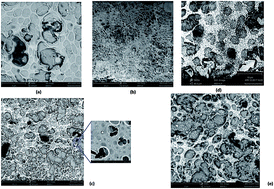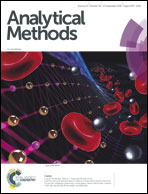Electrochemical determination of lead in human blood serum and urine by anodic stripping voltammetry using glassy carbon electrodes covered with Ag–Hg and Ag–Bi bimetallic nanoparticles
Abstract
The evaluation and application of glassy carbon electrodes modified with bimetallic nanoparticle deposits of Ag–Hg and Ag–Bi for determination of Pb(II) is described. Deposition of the nanostructured bimetallic combinations on top of the glassy carbon (GC) substrate, previously covered with a Nafion (Nf) film, resulted in electrodes with substantially enlarged hydrogen evolution over-voltage. As indicated by scanning electron microscopy and atomic force microscopy images, most of the deposited nanoparticles, with an average size of 150 nm, were uniformly dispersed inside the Nafion net while a smaller amount remained on top of the embedded ones. Sensitivity tests of the AgBiNpNf/GC modified electrode produced a detection limit (DL), based on the 3s criterion, of 0.66 μg L−1 and 0.24 μg L−1 for the AgHgNpNf/GC electrode. Accuracy was assessed by comparison with quantification of Pb(II) in human blood serum and urine samples analyzed by atomic absorption spectrometry, using a continuous source high resolution atomic absorption spectrometer.


 Please wait while we load your content...
Please wait while we load your content...